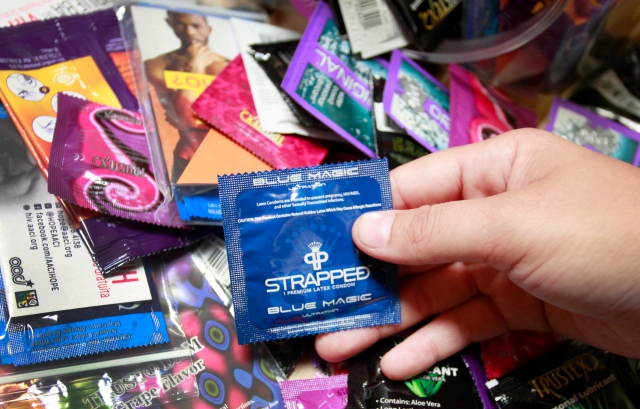HealthDay News
What’s so great about condoms?
The condom, a thin rubber sheath that fits over your erect penis, traps your semen during sex and keeps you from impregnating a female partner or infecting your partner with a sexually transmitted disease. It can also protect you from picking up one of these diseases yourself by shielding your penis from your partner’s secretions. Although they may reduce the sensitivity of your penis slightly, condoms can make sex safe and relatively spontaneous. They’re inexpensive , disposable, and readily available in drugstores, in supermarkets, and on the Web, in a variety of shapes, textures, colors, and even flavors.
Most condoms are made of latex rubber. If you or your partner is among the estimated 3 million Americans who are allergic to latex (in which case you may notice itching, tingling, or hives on skin that’s exposed to the rubber), try condoms made of polyurethane plastic or animal membrane. But be aware that animal skin — usually called “lambskin” but actually made of lamb intestine — is more porous than rubber or plastic and will not block HIV, HPV (human papilloma virus), or the virus that causes hepatitis B. Polyurethane condoms are stronger and thinner than latex, which makes them more comfortable and reliable, but they’re also pricier..
People are also reading…
Some condoms are treated with spermicide. This may give you a little extra protection against pregnancy if a condom breaks. But, according to guidelines issued by the Centers for Disease Control and Prevention, spermicides don’t protect against HIV or other STDs. In fact, says the CDC, frequent use of spermicides containing nonoxynol-9 can cause genital lesions that may actually increase your risk of contracting STDs. Additionally, many women find the chemicals in spermicides irritating and studies have shown that they can make women vulnerable to urinary-tract infections.
As for shape and texture in a condom, experiment with different brands until you find one that feels good to you and your partner. Don’t worry about size; a standard condom can stretch to accommodate any man.
For best results, put the condom on once your penis is erect, but before it touches your partner’s mouth or genitals. Be careful not to tear the condom while you’re unwrapping it. Putting a few drops of a water-based lubricant, such as K-Y Jelly, Astro-Glide, or Wet, inside the tip of the condom will increase your sensitivity there. Fit the condom onto the head of your penis like a hat. Then pinch the crown to squeeze out any air while you unroll the rest of the condom down over the entire penis, leaving some space at the tip to hold the semen. (If you’re uncircumcised, pull your foreskin back before putting on the condom.) You may also want to lubricate the outside of the condom once it’s on, to help prevent rips and tears and to make it more comfortable. After sex, pull out before your penis softens, holding the condom against the base of the penis. Slowly roll it off, and throw it away.
What can I do to keep a condom from breaking?
Every condom is checked for defects before it’s packaged, so condoms rarely tear on their own. But they can break if you don’t handle them correctly.
Don’t use a condom more than once. In fact, don’t use any condom that’s been previously opened or unrolled.
Keep things well lubricated, but use only water-based lubricants like the ones named above. Oil-based lubricants, such as Vaseline, baby oil, mineral oil, body lotion, or vegetable oil, can weaken latex rubber almost instantly and cause it to rupture. Even foods like whipped cream contain oil and can damage a condom.
Store your condoms in a cool, dry place. Don’t keep them in your wallet, glove compartment, or bathroom, where heat and humidity can cause the material to deteriorate. And don’t use a condom if it looks discolored, sticky, brittle, or stiff, or if the expiration date has passed.
What should I do if it breaks?
If a condom breaks, tell your female partner right away so that she can insert a spermicidal jelly or foam. In fact, it’s a good idea for a woman to use a back-up method, such as a diaphragm, during sex with a partner wearing a condom, just in case the condom breaks, leaks, or slips off. When used correctly and consistently, condoms are about 98 percent effective in preventing pregnancy. With typical (meaning inconsistent or incorrect) use, they are about 85 percent effective. Condoms are more effective when used with a foam or jelly.
Spermicides are less effective after the fact, though, so unless she’s using a diaphragm or another means of birth control, your female partner may also want to call her doctor and ask about getting a prescription for emergency contraception, or the “morning after” pill, which actually consists of two doses of hormone pills. She should take the first dose as soon as possible (no more than 72 hours after having unprotected intercourse), and the second one 12 hours after that. (With the ominous change in abortion laws, she may want to leave the state to get the medication from a clinic in a pro-choice state.)
Get That Condom on Right. Planned Parenthood Federation of America, Inc.
The Condom. Planned Parenthood Federation of America, Inc.
The Role of STD Detection and Treatment in HIV Prevention – CDC Fact Sheet
Hooton TM. Recurrent urinary tract infection in women. Int J Antimicrob Agents;17(4):259-68
American Latex Allergy Association. Latex Allergy Statistics.
Discovered on: 2022-12-18 20:38:44
Source: Condoms for Men



